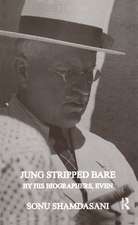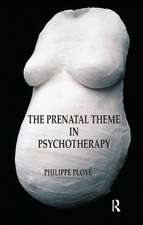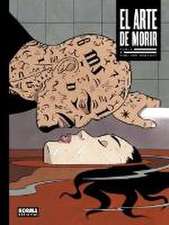Programming Interior Environments: A Practical Guide for Students
Autor Cynthia Karpanen Limba Engleză Hardback – 2 dec 2019
This book studies the Student Programming Model: a realistic programming process for college and university interior design students that allows students to create accurate and in-depth programming documents essential for informing the design process. This is done whilst keeping in mind that students are often working solo, with imaginary clients and end users in mind, and collecting program information within strict time constraints.
Including three appendices of student programs created following these guidelines, to help you understand how to apply the framework components and inquiry methods in your own work, this book is ideal for students and professionals in interior design and interior architecture.
Preț: 682.47 lei
Preț vechi: 915.39 lei
-25% Nou
Puncte Express: 1024
Preț estimativ în valută:
130.59€ • 136.63$ • 108.48£
130.59€ • 136.63$ • 108.48£
Carte tipărită la comandă
Livrare economică 02-16 aprilie
Preluare comenzi: 021 569.72.76
Specificații
ISBN-13: 9781138889675
ISBN-10: 1138889679
Pagini: 210
Ilustrații: 94
Dimensiuni: 189 x 246 x 18 mm
Greutate: 0.55 kg
Ediția:1
Editura: Taylor & Francis
Colecția Routledge
Locul publicării:Oxford, United Kingdom
ISBN-10: 1138889679
Pagini: 210
Ilustrații: 94
Dimensiuni: 189 x 246 x 18 mm
Greutate: 0.55 kg
Ediția:1
Editura: Taylor & Francis
Colecția Routledge
Locul publicării:Oxford, United Kingdom
Public țintă
UndergraduateCuprins
TABLE OF CONTENTS
LIST OF FIGURES
LIST OF TABLES
ACKNOWLEDGEMENTS
CHAPTER 1: INTRODUCTION
Intended Audience
Programming
The Design Process
The Programming Process
The Program Document
Programming Advantages
Programming Disadvantages
Chapter Overviews
Summary and Chapter Overviews
Chapter Overviews
CHAPTER 2: MODERN-DAY PROGRAMMING
1957
Mid 1960s
1969
Late 1960s and Early 1970s
Late 1970s
1980s
1990s
2000 - 2010
2010 - 2020
Summary
CHAPTER 3: INTERIOR DESIGN PROGRAMMING MODELS
Seven Interior Design Programming Models
Student Programming Model Overview
Student Programming Model
Summary
CHAPTER 4: COLLECTION
Overview
Organize
Existing Condition
People
Workflow
Products
Site
Building and Space
Desired Condition
Context
People
Workflow
Products
Site
Building and Space
Collection Methods, Sources, and Products
Collection Methods
Collection Sources
Collection Products
Summary
CHAPTER 5: ANALYSIS
Overview
Themes
Options
Project Objectives
Design Guidelines
Analysis Methods
Dissect (Text)
Crunch (Numbers)
Assess
Annotate
Draw
Analysis in Action
Analysis Products
Summary
CHAPTER 6: SYNTHESIS
Methods
Constant Comparison
Priorities
Content Options
Abstract
Executive Summary
Table of Contents, List of Figures, List of Tables
Project Overview
Project Goals, Assumptions, and Objectives
Site, Building, and Space Descriptions
Building Code Information
Client Description
Workflow
End User Profiles, Needs, and Activities
Activity Zone Requirements
Area Requirements
Spatial Adjacency Matrices
Zoning and Stacking Diagrams
Circulation Diagrams
Design Guidelines
Schematic Concept Drawings
References
Appendices
Content Format and Order
Synthesis Products
Summary
CHAPTER 7: EVALUATE AND REVISE, COMMUNICATE
Evaluation
Review
Compare
Revise
Communicate
Audience
Purpose
Time
Summary
CHAPTER 8: SUMMARY AND CONCLUSION
Summary
Conclusion
APPENDIXES
A Blackthorn Live/Create Program
B The HUB Program
C Extreme Toy Hauler Mobile Showroom Program
INDEX
LIST OF FIGURES
LIST OF TABLES
ACKNOWLEDGEMENTS
CHAPTER 1: INTRODUCTION
Intended Audience
Programming
The Design Process
The Programming Process
The Program Document
Programming Advantages
Programming Disadvantages
Chapter Overviews
Summary and Chapter Overviews
Chapter Overviews
CHAPTER 2: MODERN-DAY PROGRAMMING
1957
Mid 1960s
1969
Late 1960s and Early 1970s
Late 1970s
1980s
1990s
2000 - 2010
2010 - 2020
Summary
CHAPTER 3: INTERIOR DESIGN PROGRAMMING MODELS
Seven Interior Design Programming Models
Student Programming Model Overview
Student Programming Model
Summary
CHAPTER 4: COLLECTION
Overview
Organize
Existing Condition
People
Workflow
Products
Site
Building and Space
Desired Condition
Context
People
Workflow
Products
Site
Building and Space
Collection Methods, Sources, and Products
Collection Methods
Collection Sources
Collection Products
Summary
CHAPTER 5: ANALYSIS
Overview
Themes
Options
Project Objectives
Design Guidelines
Analysis Methods
Dissect (Text)
Crunch (Numbers)
Assess
Annotate
Draw
Analysis in Action
Analysis Products
Summary
CHAPTER 6: SYNTHESIS
Methods
Constant Comparison
Priorities
Content Options
Abstract
Executive Summary
Table of Contents, List of Figures, List of Tables
Project Overview
Project Goals, Assumptions, and Objectives
Site, Building, and Space Descriptions
Building Code Information
Client Description
Workflow
End User Profiles, Needs, and Activities
Activity Zone Requirements
Area Requirements
Spatial Adjacency Matrices
Zoning and Stacking Diagrams
Circulation Diagrams
Design Guidelines
Schematic Concept Drawings
References
Appendices
Content Format and Order
Synthesis Products
Summary
CHAPTER 7: EVALUATE AND REVISE, COMMUNICATE
Evaluation
Review
Compare
Revise
Communicate
Audience
Purpose
Time
Summary
CHAPTER 8: SUMMARY AND CONCLUSION
Summary
Conclusion
APPENDIXES
A Blackthorn Live/Create Program
B The HUB Program
C Extreme Toy Hauler Mobile Showroom Program
INDEX
Notă biografică
Cynthia M. Karpan is an Associate Professor of Interior Design at the University of Manitoba in Winnipeg, Manitoba, Canada.
Recenzii
"Karpan comprehensively deals with the most intractable conundrum in design education: preparing our students to enter the work-force when our university courses cannot replicate future, real-life situations. Chapter by chapter, she systematically unpicks the complexities of programming and, in doing so, provides a framework for students that it is valuable, necessary and manageable."
Russell Gagg, Principal Lecturer Interior Architecture and Design, Arts University Bournemouth
"This textbook describes the background of programming that supports its use and, then, introduces students to a method especially suitable for lower division students. It provides an excellent companion to other programming related textbooks that allows upper division students to learn a wide-range of programming views before entering the workforce."
Linda L. Nussbaumer, PhD, IDEC, NCIDQ
"Strong, thoughtful programming is the foundation of effective design solutions. In this book, Cynthia has covered all the bases – both the theoretical and the practical in a narrative style that is informal and engaging. This will be an asset to students and teachers in developing designers with strong programming skills."
Carol Jones, BID, RID, FIDC, FIIDA, ASID, LEED AP, D.Litt
Russell Gagg, Principal Lecturer Interior Architecture and Design, Arts University Bournemouth
"This textbook describes the background of programming that supports its use and, then, introduces students to a method especially suitable for lower division students. It provides an excellent companion to other programming related textbooks that allows upper division students to learn a wide-range of programming views before entering the workforce."
Linda L. Nussbaumer, PhD, IDEC, NCIDQ
"Strong, thoughtful programming is the foundation of effective design solutions. In this book, Cynthia has covered all the bases – both the theoretical and the practical in a narrative style that is informal and engaging. This will be an asset to students and teachers in developing designers with strong programming skills."
Carol Jones, BID, RID, FIDC, FIIDA, ASID, LEED AP, D.Litt
Descriere
Programming Interior Environments introduces a four-component framework you can use to program interiors, and twelve methods for you to gather, analyse and synthesise programmatic information to take the guesswork out of your studio projects.






















